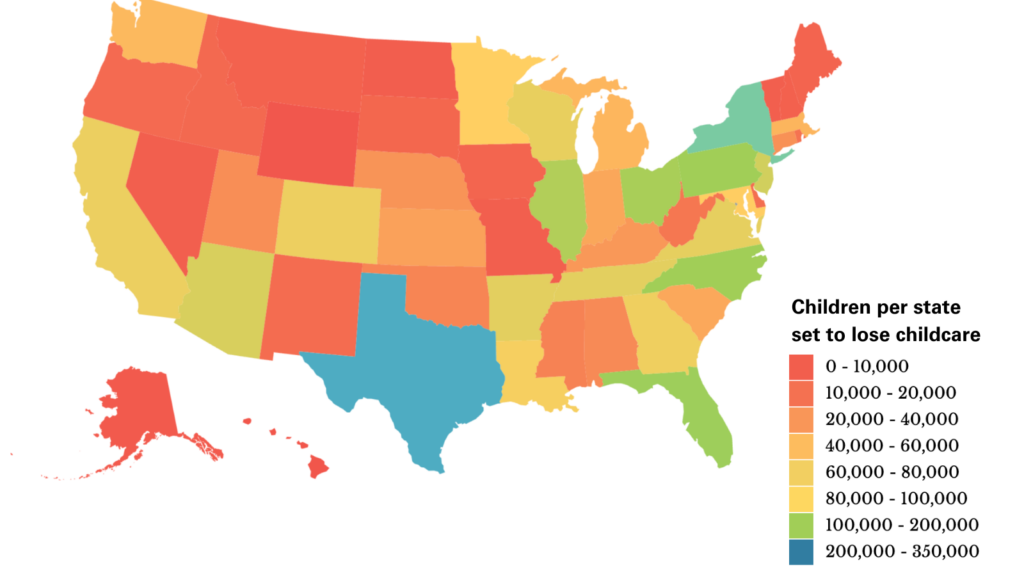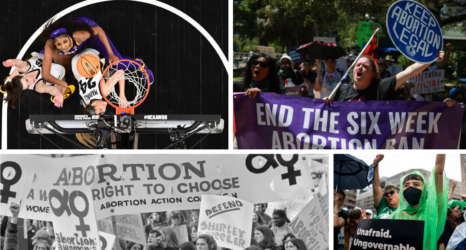Congress averted a shutdown, but not a childcare cliff. Childcare centers and their families will pay the price.

Update Friday, Oct. 6, 2023, at 8:30 a.m. PT: Passed in January 2021 with the goal of providing COVID-era relief, the American Rescue Plan Act (ARPA) allocated $39 billion towards childcare programming. The majority—$24 billion—went directly to childcare and daycare centers, to help the programs remain open and staffed.
On Sept. 30, that funding expired, and Congress took no action to extend it. Last month, Senate Democrats introduced The Child Care Stabilization Act, a bill to extend childcare stabilization funding for five years. But until the measure gets support from Republicans, it cannot be considered for a vote.
“Families all over this country are struggling as a direct result of the inaction from Congress,” said Nicole Jorwic, chief of advocacy and campaigns at Caring Across Generations. “Our economy will not be able to fully recover and thrive if people who are already squeezed by the lack of investments in family-first policies have even more taken away. It is critical Congress stop manufacturing crises and instead, take care of their constituents.”
This report was originally published by The Century Foundation.
Beginning Sept. 30, 2023, states will face a steep dropoff in federal childcare investment. Without congressional action, this cliff will have dire consequences.
More than 3 million children are projected to lose access to childcare nationwide, and 70,000 childcare programs are likely to close. This will have ripple effects for parents forced out of work or to cut their work hours, for businesses who will lose valuable employees or experience the impact of their employees’ childcare disruptions, and state economies that will lose tax revenue and jobs in the childcare sector as a result.

In the first-ever economic analysis of the looming childcare cliff, The Century Foundation has projected the impact of the cutoff for children, families, and state economies, including for all 50 states and the District of Columbia.
We find that:
- More than 70,000 childcare programs—one-third of those supported by American Rescue Plan stabilization funding—will likely close, and approximately 3.2 million children could lose their childcare spots.
- The loss in tax and business revenue will likely cost states $10.6 billion in economic activity per year.
- In addition, we project that millions of parents will be impacted, with many leaving the workforce or reducing their hours, costing families $9 billion each year in lost earnings.
- The childcare workforce, which has been one of the slowest sectors to recover from the pandemic, will likely lose another 232,000 jobs.
- In six states—Arkansas, Montana, Utah, Virginia, West Virginia, as well as Washington, D.C.—the number of licensed programs could be cut by half or more. In another fourteen states, the supply of licensed programs could be reduced by one-third.
Our findings underscore the urgent need for immediate funding and long-term comprehensive solutions at the federal level that offer safe, nurturing, and affordable childcare options to every family.
Additionally, TCF’s new nationwide public opinion polling, conducted by Morning Consult, shows that a strong majority of Americans are concerned about the looming childcare cliff and overwhelmingly prefer candidates for office who champion policies to expand quality, affordable childcare. (A summary of the polling is available here.)
High quality, affordable and accessible childcare is a national priority that benefits everyone.
*
Darlene Brannan runs Kids Korner Academy in Durham, N.C. Kids Korner Academy has been operating since 2009, serving children ages 6 weeks to 13 years. At the height of the COVID-19 pandemic, they took out a loan to keep their program open, grateful for their dedicated teachers who came to work every day, and created a virtual option for their school-age children. Childcare stabilization funds from the American Rescue Plan Act (ARPA) allowed them to reduce tuition, raise staff pay to about $20 an hour, offer professional development, and bring in new toys and furniture to make it a great place for kids during a stressful time.
The children and families served by Kids Korner Academy have benefited from the well-paid and trained early educators, the reduction in childcare tuition, and an engaging environment that ARPA funds made possible. And they are in good company with the millions of children and their families around the nation whose childcare programs have received this kind of support.
Just like clean water, safe food, and good public schools, high quality, affordable and accessible childcare is a national priority that benefits everyone. Families across all income levels share the same determination to provide the best possible foundation for their children, especially in their early years. Two-thirds of children under age 6 have all of their parents (either solo or coupled) in the workforce. Parents need the freedom to afford childcare and to have peace of mind that their children are safe and nurtured while parents go to work or to school and make the choices that are best for their families.
Families throughout the United States need a variety of affordable childcare options that employ qualified and caring early educators who are able to meet children’s diverse needs and help them thrive. But this is not the reality for most families, who are obstructed at every turn by a scarcity of childcare options that meet their budget or needs.
The average annual cost of childcare currently is more than $10,000 per year for one child, and in some states, it’s as much as $15,000 to $20,000 per year. That’s more than the price of a mortgage, rent or public college tuition in most states. Nor is it the reality for many child care providers, who are finding it increasingly difficult to hire or retain passionate staff members who can support themselves on child care’s paltry wages—an average of $13.50 an hour for their complex and valuable work.
The average annual cost of childcare currently is more than $10,000 per year for one child, and in some states, it’s as much as $15,000 to $20,000 per year.
The problem of high tuition prices, low early educator wages, and decreasing program supply has grown in severity for several decades, but was pushed to crisis levels by the COVID-19 pandemic, which laid bare the vulnerabilities and limitations of the United States’ childcare system. All told, the United States lost an estimated 20,000 childcare programs in the first two years of the pandemic, nearly 10 percent of its pre-pandemic amount of childcare programs. Though these numbers represent a devastating setback for thousands of impacted children, families, and early educators, the toll could have been far worse.
The COVID-19 pandemic also made clear how great of an impact federal investment in childcare and early learning can have: when a devastating disease caused an historic economic downturn, the federal government responded by making unprecedented investments in the American people and economy. The American Rescue Plan Act (ARPA), passed in 2021, gave states close to $40 billion in federal emergency relief funds for childcare, which proved a much-needed lifeline for many child care providers.
While the pandemic sent the childcare sector deeper into crisis, ARPA stabilization funds prevented it from collapsing altogether. The U.S. Department of Health and Human Services found that the $24 billion in relief funds distributed to states served 220,000 childcare providers, saved the jobs of more than 1 million early educators, and enabled continued care for as many as 9.6 million children.
Child Care Aware of America recently found that, with the stabilization funding out in the field, the number of licensed child care centers returned to pre-pandemic levels in 2022, and the trend of declining family child care homes slowed.
The ARPA stabilization funds that staved off the childcare sector’s collapse will come to an abrupt end in September 2023. When these resources swiftly and suddenly disappear, this funding cliff will once again place the sector in danger, as it will be forced to contract, shedding caregivers and care slots in a cascade that will not only upend millions of families’ childcare arrangements but also hurt regional economies.
In this report, we analyze what children, families, and state economies stand to lose once the United States hits the “childcare cliff.”
Continue reading this analysis on The Century Foundation.
Up next:
U.S. democracy is at a dangerous inflection point—from the demise of abortion rights, to a lack of pay equity and parental leave, to skyrocketing maternal mortality, and attacks on trans health. Left unchecked, these crises will lead to wider gaps in political participation and representation. For 50 years, Ms. has been forging feminist journalism—reporting, rebelling and truth-telling from the front-lines, championing the Equal Rights Amendment, and centering the stories of those most impacted. With all that’s at stake for equality, we are redoubling our commitment for the next 50 years. In turn, we need your help, Support Ms. today with a donation—any amount that is meaningful to you. For as little as $5 each month, you’ll receive the print magazine along with our e-newsletters, action alerts, and invitations to Ms. Studios events and podcasts. We are grateful for your loyalty and ferocity.





